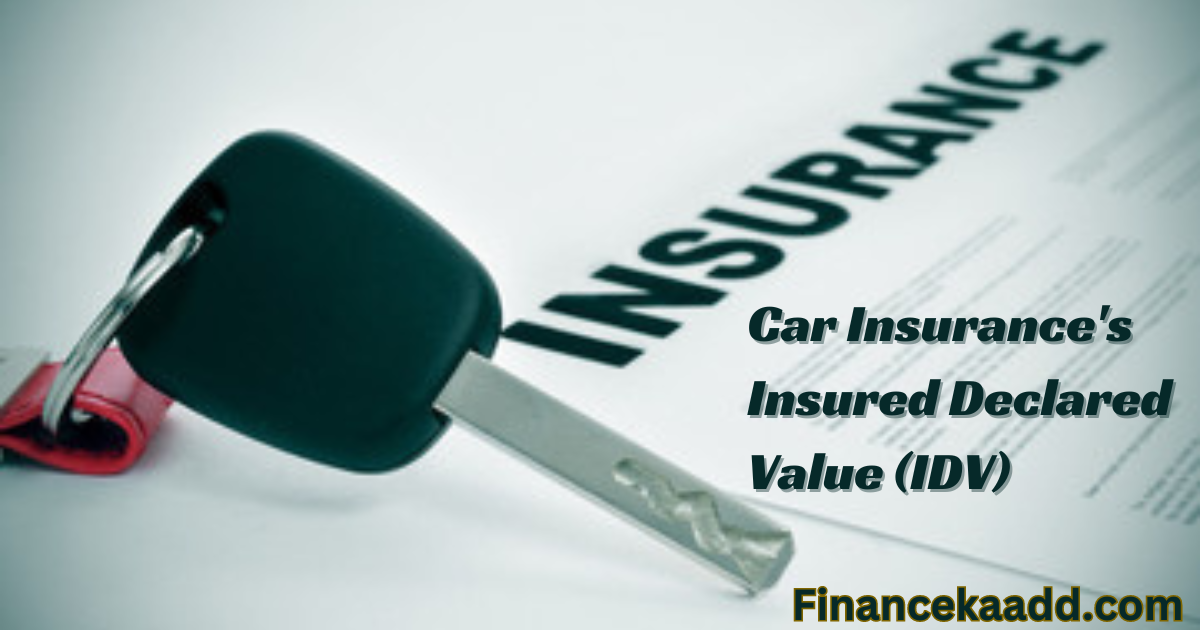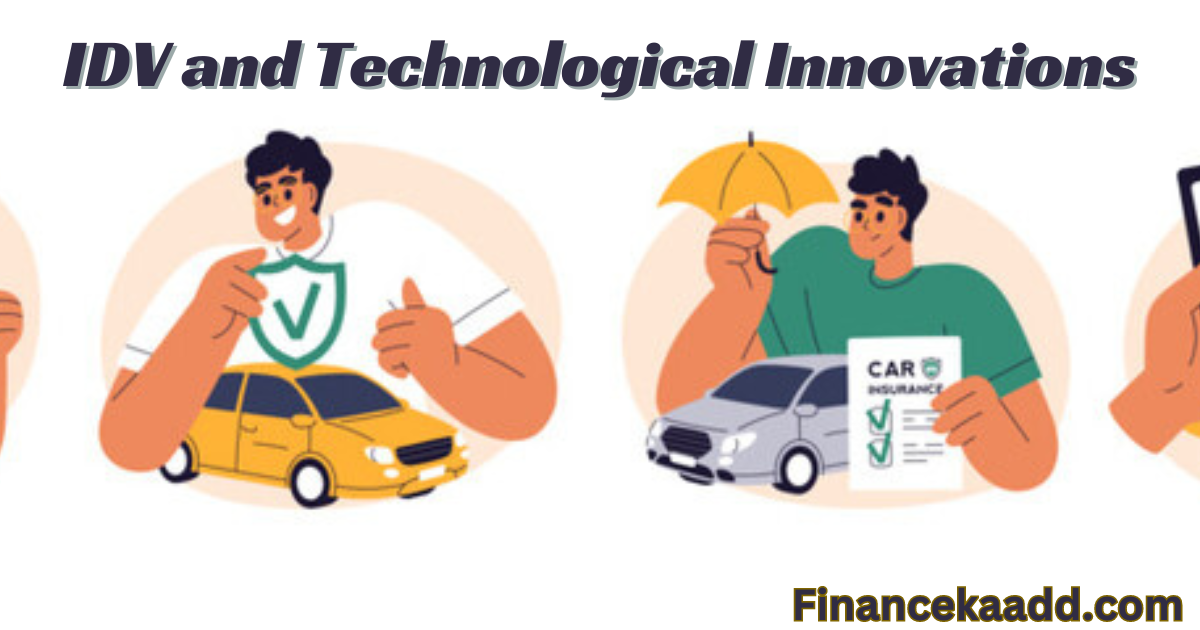Car Insurance’s insured declared value (IDV) is more than just a protective shield against traffic rule violations; it’s a long-term investment safeguarding you from the financial ramifications of various vehicle-related mishaps. When navigating the realm of four-wheeler insurance, one must grasp the intricacies of the insured declared value (IDV), a pivotal factor influencing policy premiums and claim settlements.
Car Insurance’s Insured Declared Value (IDV) in Insurance
IDV, or Insured Declared Value, essentially represents the market price of a car. It signifies the maximum amount your insurance provider would offer in the unfortunate event of theft or irreparable damage. Understanding the nuances of IDV is crucial, as it directly impacts your car insurance policy’s premium and claim settlement threshold.
The Significance of IDV in Car Insurance
The value of IDV in car insurance extends beyond its surface definition. It plays a critical role in:
Determining Maximum Compensation
Your car’s maximum compensation hinges on its IDV. A higher IDV implies a higher risk level, consequently influencing the insurance premium.
Assessing Risk Levels
Insurers gauge a car’s risk level based on its IDV. A higher IDV corresponds to a higher premium, reflecting the potential financial exposure.
Guiding Claim Settlements
During claim settlements, repair and replacement costs are derived from the car’s IDV. Therefore, understanding IDV is vital for accurate claim reimbursements.
Calculating IDV for Car Insurance
Utilizing an IDV calculator or manual calculations, one can determine the insured’s declared value. The formula involves deducting depreciation from the manufacturer’s listed price.
Factoring in Accessories
For cars with added accessories, a modified formula includes the depreciation value of these accessories in the IDV calculation.
The IRDAI Depreciation Schedule
The Insurance Regulatory and Development Authority of India (IRDAI) prescribes depreciation rates for the initial 5 years, influencing the IDV calculation. For cars older than 5 years, IDV is mutually decided based on the car’s condition and survey reports.
Components Influencing Car Insurance IDV
Several elements contribute to a car’s IDV calculation, including registration details, location, showroom price, registration date, make and model, and engine cubic capacity.
Considerations When Calculating IDV
Valuing a car’s IDV involves deducting depreciation, fuel, and maintenance costs. A precise valuation can lead to a lower insurance premium and justifiable claim settlements.
Factors Impacting Car Insurance IDV
The IDV is shaped by factors such as the car’s age, type, registration city, standard depreciation rates, and the value of additional accessories.
Age of the Car
A car’s age directly influences its IDV, with older cars having a lower IDV compared to new ones.
Type of Car
Different car types have varying features and prices, impacting their respective IDVs.
City of Registration
High-traffic metropolitan cities pose higher risks, affecting the IDV of cars registered there.
Depreciation
Standard depreciation rates from IRDAI contribute to IDV calculations, increasing as the car ages.
Accessories
Added accessories contribute to IDV, factoring in their depreciation based on age and condition.
FI MONEY PERSONAL LOAN👉APPLY NOW
Adjusting IDV: Pros and Cons
Decreasing IDV
Advantages
- Reduced Premium: Lowering IDV leads to a decreased premium, saving money over time.
Disadvantages
- Lower Sum Insured: In the event of theft, a lower IDV results in a diminished claim settlement.
Increasing IDV
Advantages
- Higher Sum Assured: A boosted IDV ensures a higher sum assured and substantial claim amounts.
Disadvantages
- Costlier Premium: An elevated IDV leads to a pricier insurance policy.
Optimal IDV Selection
Choosing the right IDV depends on factors like the car’s market value, your budget, and the desired sum insured.
Low IDV Scenarios
- Older Cars: Opt for a lower IDV if your car is old and lacks significant market value.
- Budget Constraints: Choose a lower IDV to align with budget constraints without compromising coverage.
High IDV Scenarios
- Luxury Cars: Select a higher IDV for expensive or luxury cars.
- Expensive Spare Parts: Cars with pricey, hard-to-find spare parts benefit from a higher IDV.
- Budget Flexibility: If a higher premium aligns with your budget, opt for a higher IDV for comprehensive coverage.
IDV and Claims
While IDV isn’t directly required for claim calculations, it plays a crucial role in claim settlements for theft, constructive total loss, and total loss scenarios.
INCRED PERSONAL LOAN 👉APPLY NOW
Dispelling IDV Myths
Myth: Immutable IDV
Fact: Policyholders can negotiate the suggested IDV, comparing it with similar cars and the desired sum assured.
Myth: IDV Equals Resale Value
Fact: A car’s resale value is influenced by various factors beyond IDV.
Myth: Significant Savings with Lower IDV
Fact: While a low IDV reduces premiums, potential post-accident costs may offset initial savings.
IDV and Premium Dynamics
IDV’s relevance is evident in comprehensive car insurance policies, with annual adjustments reflecting the car’s diminishing market value.
For an all-encompassing car insurance experience, explore Tata AIG’s 12 policy riders to enhance coverage. Utilize our car insurance calculator for premium insights tailored to your coverage preferences and budget considerations.
MONEYVIEW PERSONAL LOAN👉APPLY NOW
Understanding the Dynamic IDV-Insurance Relationship
IDV and Policy Renewal
IDV is a key consideration during policy renewal, necessitating an annual reassessment. As your car ages, its market value diminishes, impacting the IDV and, consequently, the premium. This cyclical adjustment ensures that your coverage aligns with the current market conditions.
Smart IDV Management
Efficient IDV management involves periodic reassessment, considering the car’s age, depreciation, and any modifications. Staying informed about standard depreciation rates ensures accurate calculations, helping you strike the right balance between premium affordability and adequate coverage.
Navigating the Claim Scenario
Stolen Vehicles
In cases of theft where your car is declared non-traceable by the police, the insurer compensates you with the car’s IDV. It underscores the importance of an accurately declared IDV for fair reimbursement.
Constructive Total Loss
Extreme damages due to accidents, earthquakes, or other unforeseen events may render your car irreparable. In such instances, a claim for total damages is filed, with the IDV acting as a benchmark for compensation.
Total Loss Scenarios
When your car is damaged beyond repair, resulting in a total loss, the insurer provides compensation based on the car’s IDV. This emphasizes the role of IDV in determining the financial settlement in critical situations.
Debunking Common Myths
Flexibility in IDV
Contrary to the misconception that IDV is non-negotiable, policyholders can actively participate in determining the IDV. Comparing it with similar models and aligning it with the desired sum assured empowers policyholders in this decision-making process.
IDV and Resale Value
Understanding that IDV and resale value are distinct entities is crucial. A car’s resale value depends on a myriad of factors, making it imperative to avoid conflating it with the IDV.
Balancing Savings and Costs
While a lower IDV may lead to initial premium savings, potential post-accident costs could offset these savings. Striking a balance between a reasonable IDV and long-term cost implications is key to a judicious insurance strategy.
INDUSLND BANK PERSONAL LOAN 👉APPLY NOW
Strategic IDV Choices
Tailoring IDV to Car Characteristics
For older cars with diminished market value, opting for a lower IDV aligns with their actual worth. This ensures policy premiums remain manageable while providing adequate coverage.
Luxury Car Considerations
In the realm of luxury cars or those with expensive spare parts, a higher IDV safeguards against potential financial setbacks. It ensures that the sum assured is substantial, offering comprehensive protection.
Budgetary Flexibility
Choosing a higher IDV may lead to a costlier premium, but it provides financial comfort in the face of extensive damages or the need for a new vehicle. It’s a strategic choice for those with budgetary flexibility.
Final Thoughts
Navigating the intricacies of IDV in car insurance is pivotal for informed decision-making. From smart IDV management to strategic choices based on your car’s characteristics and your budget, understanding the nuanced relationship between IDV and insurance dynamics ensures a comprehensive and tailored coverage plan.
For a seamless car insurance experience, explore Tata AIG’s array of policy riders, allowing you to customize coverage according to your specific needs. Utilize our user-friendly car insurance calculator to gain insights into the premium structures that align with your coverage preferences and financial considerations.
Harnessing IDV Wisdom for Optimal Coverage
Adapting IDV to Market Fluctuations
Given that IDV is tied to market dynamics, regularly reassessing your car’s value ensures that your insurance coverage stays relevant. This adaptability is particularly crucial in an ever-changing automotive landscape.
IDV as a Risk Mitigation Tool
Understanding that IDV influences risk perception for insurers highlights its role as a risk mitigation tool. A well-calibrated IDV not only aligns with your car’s worth but also fosters a fair risk assessment, impacting premiums sensibly.
Empowering Policyholders with Knowledge
Educational Initiatives on IDV
Empowering policyholders with knowledge of IDV intricacies is pivotal. Insurers can enhance customer education by offering insights into how IDV influences premiums and claim settlements. An informed policyholder is better equipped to make judicious decisions.
Transparent IDV Communication
Insurers can enhance transparency by clearly communicating how IDV is calculated. This clarity demystifies the process for policyholders, fostering trust and ensuring they grasp the significance of their chosen IDV.
IDV and Technological Innovations
Digital Tools for IDV Assessment
Leveraging technological advancements, insurers can introduce user-friendly digital tools for IDV assessment. These tools could simplify the calculation process and offer real-time insights, making the IDV determination more accessible for policyholders.
AI Integration for Precise IDV Calculation
The integration of artificial intelligence (AI) in IDV calculations can enhance precision. AI algorithms can consider a multitude of factors swiftly, providing a nuanced IDV that accurately reflects the car’s current value.
Collaborative IDV Decision-Making
Consulting Stakeholders
Creating a collaborative environment involves consulting various stakeholders. Insurers, policyholders, and even car manufacturers could collectively contribute insights for a well-rounded IDV decision-making process.
Dynamic IDV Adjustments
Considering the dynamic nature of the automotive industry, insurers can explore models where IDV adjustments are more flexible. This adaptability ensures that insurance policies stay in sync with evolving market conditions.
KISSHT PERSONAL LOAN👉APPLY NOW
IDV: A Cornerstone for Holistic Coverage
Striking the Right Balance
In the delicate dance between premium affordability and comprehensive coverage, IDV emerges as a cornerstone. Striking the right balance requires astute decision-making, considering the car’s characteristics, budget constraints, and the desired level of coverage.
Future-proofing Insurance Dynamics
As the automotive landscape evolves, the insurance industry must adapt. Future-proofing insurance dynamics involves continuous refinement of how IDV is calculated and applied, ensuring relevance in the face of emerging trends.
Conclusion
The journey through the intricacies of IDV in car insurance reveals its multifaceted role. From risk mitigation and transparent communication to embracing technological innovations, the realm of IDV is ripe for evolution. As we navigate the future, a harmonious collaboration between stakeholders and a commitment to informed decision-making will elevate the significance of IDV in shaping the landscape of car insurance.
Frequently Asked Questions (FAQ) about Car Insurance and IDV
Q1: What does IDV stand for in car insurance?
Ans: IDV stands for Insured Declared Value. It represents the market price of a car and is the maximum amount an insurance provider will offer in case of theft or irreparable damage.
Q2: Why is IDV important in car insurance?
Ans: IDV plays a crucial role in determining the premium of a car insurance policy. It also influences the maximum compensation a policyholder can receive in the event of a claim, making it a key factor in insurance coverage.
Q3: How is IDV calculated for car insurance?
Ans: The IDV is calculated by deducting the depreciation value from the manufacturer’s listed price. For cars with additional accessories, the formula includes the depreciation value of those accessories.
Q4: What factors affect a car’s IDV?
Ans: Several factors impact a car’s IDV, including its age, type, the city of registration, standard depreciation rates, and the value of additional accessories.
Q5: Should I opt for a higher or lower IDV for my car insurance?
Ans: The choice between a higher or lower IDV depends on various factors. Opt for a lower IDV for older cars with diminished market value or if budget constraints are a concern. Choose a higher IDV for luxury cars or vehicles with expensive spare parts.
Q6: Can I change the IDV decided by the insurance provider?
Ans: Yes, policyholders can negotiate the suggested IDV. It’s advisable to compare it with similar cars and align it with the desired sum assured.
Q7: How does IDV affect car insurance premiums?
Ans: A higher IDV generally results in a higher car insurance premium, while a lower IDV leads to a reduced premium. Striking the right balance is essential for optimal coverage and affordability.
Q8: Is IDV required for all types of car insurance policies?
Ans: IDV is relevant for comprehensive car insurance policies. For third-party car insurance, which covers damages to third-party vehicles and property, IDV is not applicable.
Q9: What happens if my car is stolen or faces total loss?
Ans: In cases of theft or total loss, the insurer compensates approximately the car’s IDV. It serves as a benchmark for determining the reimbursement amount.
Q10: How often should I reassess my car’s IDV?
Ans: It is advisable to reassess your car’s IDV annually, especially during policy renewal. As your car ages, its market value decreases, impacting the IDV and, consequently, the premium.


